Ancient Thera
One of the most prominent excavation sites within the Aegean Islands
One of the most prominent excavation sites within the Aegean Islands
Ancient Thera stands on Mesa Vouno, at an altitude of 396 m. It was founded in the 9th century BC by Dorian settlers, led by Theras; habitation continued until the early Byzantine era. Excavations have mainly brought to light the areas built during 2007. Routes are well-planned and marked with signs.
The position is naturally fortified because the steep slopes of the mountain made the city inaccessible from land or sea and also a great observatory to the SE Aegean Sea. Public and private buildings are built along the main axis of the city in direction from the NE to the SE corner of the rock. Smaller cobbled streets adapted to the terrain, intersected the main road.
Building remnants belong to the Hellenistic era, which is the last period of the city’s prosperity. The residential development is amphitheatrical due to the inclination of the terrain and to the building in such way so there was a view of the sea.
Few private houses have been excavated organized in neighborhoods, mainly in the eastern part of town. The habitation sites were built around a closed courtyard and beneath it was a tank collecting rain water. Homes had more or less spaces, or were developed vertically with a second floor depending on the social and financial status of the residents. (Data taken from the text of archeologist Angeliki Birtacha in the book “Santorini: And the sea brought forth the earth”/ Topio Publications).

THE SANCTUARY OF ARTEMIDOROS: The rock-hewn sanctuary, dating back to the late 4th/early 3rd century BC, was founded by Artemidoros of Perge, admiral of the Ptolemaic fleet. Engraved inscriptions and symbols of gods worshiped at the time can be seen on the rocks.
THE AGORA: Built at the city centre, its south side was the commercial centre, while the middle part was the administrative centre of the city. At the northern part, constructed during the Roman years, there are several monuments, a stoa, and temple-shaped buildings.
THE ROYAL STOA: Dating from the era of Augustus (1st century AD), it stands at the SW edge of the agora. Statues of the Caesar’s family stood at its northern side; on the western wall, two insert inscribed plates mention that the stoa was restored by the Cleitosthenes, a wealthy resident of Thira, in 149 AD.
THE TEMPLE OF DIONYSUS: North of the Agora stands a small Hellenistic temple of Doric order, dedicated to Dionysus. The façade and roof were marble, while the rest of the building was made of locally-mined stone. It dates from the 3rd century BC.
THE AREA OF THE SANCTUARIES: At the southeast edge of the city, it contains only open-air or covered sanctuaries, dedicated to Apollo Karneios, Hermes, Hercules, Ptolemy III, and others. In addition, there is the square where the festivities to honor Apollo Karneios (Gymnopaediae) took place. There are many inscriptions ranging from the Archaic to the Roman period engraved on the rocks.
THE SANCTUARY OF APOLLO KARNEIOS: Dating back to the 6th century BC, it is partly rock-hewn and partly built on a retaining wall. It comprises the temple, a square yard with an underground cistern, and a small building, possibly a sacristy.
GYMNASIUM FOR EPHEBES: Dating from the 2nd century AD, it stands on the south side of the city; a partly rock-hewn cave survives, dedicated to Hermes and Hercules.
THE CEMETERIES: On the hillsides of Sellada and flanking the roads to the northern and southern ports of the ancient city –the modern Kamari and Perissa respectively– lie the cemeteries of Ancient Thira. Burials ranging from the Geometric up to the Roman period have been uncovered.
THE THEATRE: Built in the era of the Ptolemies (3rd century BC), it stands on the SE part of the Agora. In the 1st century AD, the stage was expanded, occupying part of the original orchestra.
The site is open from 8:30-14:30; Mondays closed. For information, please contact the museum of Prehistoric Thera:
Tel.: +30 22860 23217
Ancient Thera and the largest part of its cemeteries were excavated by the German archaeologist Friedrich Hiller von Gaertringen, from 1895 to 1902; the Sellada cemeteries were excavated by N. Zafeiropoulos from 1961 to 1982.
In November 2000, an exquisite female statue of a Daedalic-style Kore, dating back to 600 BC, was found in the cemetery by archaeologist Charalambos Sigalas.
